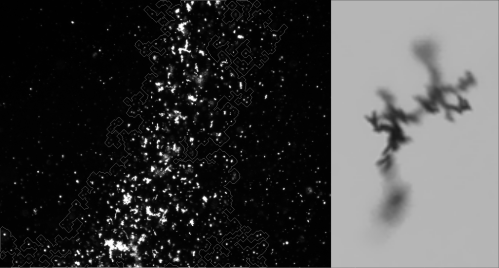ICAPS Sounding Rocket - Particle Growth
- 1Institut für Geophysik und extraterrestrische Physik (IGeP), TU Braunschweig, Brunswick, Germany (b.schubert@tu-bs.de)
- 2Microgravity Research Center (MRC), Université Libre de Bruxelles, Brussels, Belgium
The study of dust agglomeration has been a prevalent subject in laboratory astrophysics since its inception. It aims to bridge the gaps in our understanding of early planet formation and helps us interpret the data we receive from telescopes like ALMA, which observe protoplanetary disks.
As a contribution to this field, the ICAPS experiment (Interactions in Cosmic and Atmospheric Particle Systems) studies the agglomeration of micrometer-sized, monomeric silica grains under microgravitational conditions. To achieve stable microgravity, the experiment flew onboard the Texus 56 sounding rocket, continuously monitoring and controlling the movement of the dust cloud inside the vacuum chamber. For this, ICAPS employed and tested a novel approach, the thermal trap. It consists of four rings that are fitted with heating elements to keep the cloud centered using thermophoresis. The data from two overview cameras with perpendicular fields of view is used as a reference for the thermal trap. An exemplary image of the cloud can be found on the left hand side of the below figure. The right hand side shows an agglomerate as seen by the on-board long distance microscope and captured by a high speed camera.

However, the main focus of this session lies on the scientific results. Within the first two minutes, the silica grains grew to agglomerates of around 103-104 constituent particles via hit-and-stick collisions. The analysis revealed insight into their collision speed, rate of growth and fractal dimension. Also, the influence of their charge could be studied because at several stages of the experiment an electric field was applied. In particular, it was possible to reconstruct some particles in three dimensions by linear displacement through the focal plane of the long distance microscope using the thermal trap. With these findings, it will be possible to classify the growth processes at play.
How to cite: Schubert, B., Blum, J., Molinski, N., Vedernikov, A., Balapanov, D., von Borstel, I., Rüffert, L., Aktas, C., Schräpler, R., and Westermeier, M.: ICAPS Sounding Rocket - Particle Growth, Europlanet Science Congress 2020, online, 21 Sep–9 Oct 2020, EPSC2020-567, https://doi.org/10.5194/epsc2020-567, 2020.

